We occasionally link to goods offered by vendors to help the reader find relevant products. Some of these may be affiliate based, meaning we earn small commissions (at no additional cost to you) if items are purchased. Here is more about what we do.
Although we are able to get many fruits and vegetables throughout the year due to global imports and exports, I try my best to use seasonally and locally grown fresh produce whenever possible.
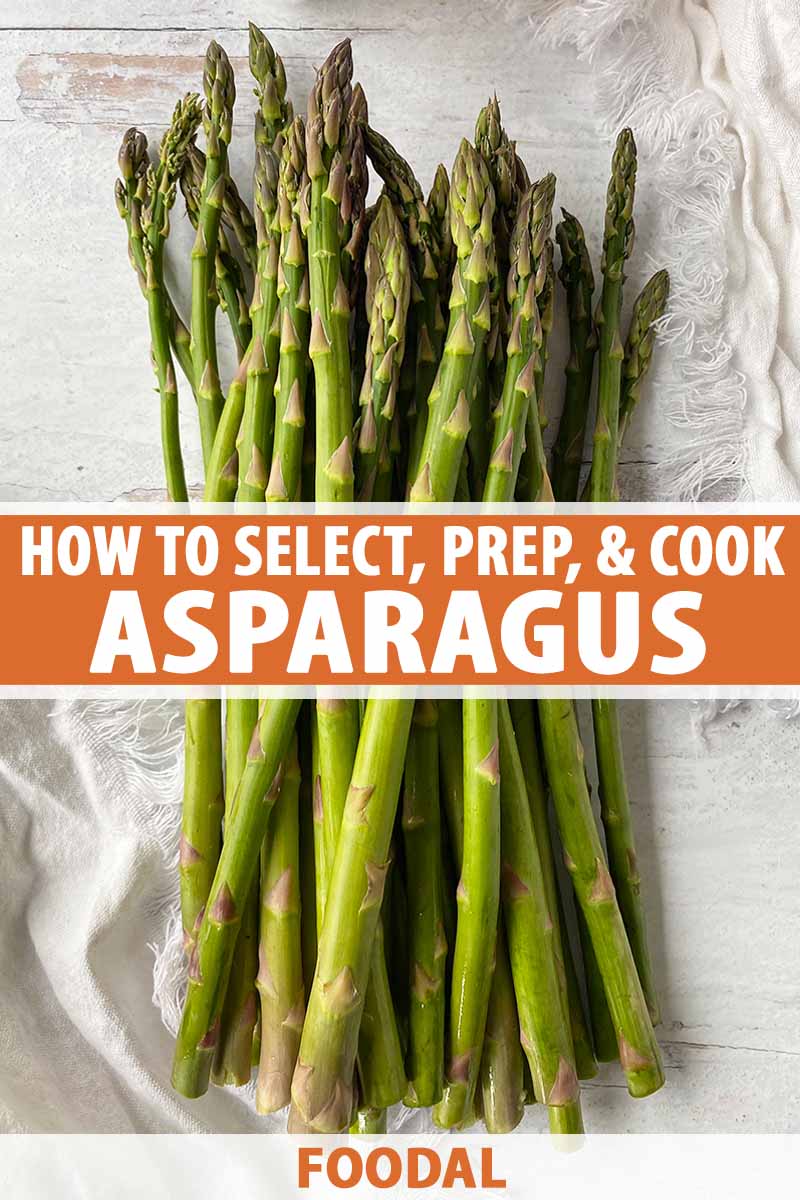
And now that spring is – finally!!!!! – here, there is one very special vegetable I can’t wait to find at the farmers markets:
Fresh asparagus!
With crisp stalks, feathery tips, and an array of colors, asparagus is a beautiful veggie I love to buy when it becomes seasonally available every year.
If you feel the same giddiness as I do, this guide is yours to embrace with open arms and big appetites.
We’ll review with you all the necessary basics in our thorough guide, and go over how to buy, prep, and cook with these brilliant spears.
How to Select, Prep, and Cook Asparagus
Getting to Know Asparagus
Asparagus (Asparagus officinalis) has been foraged, grown, and enjoyed for years, dating back to ancient Greek and Roman cultivation.
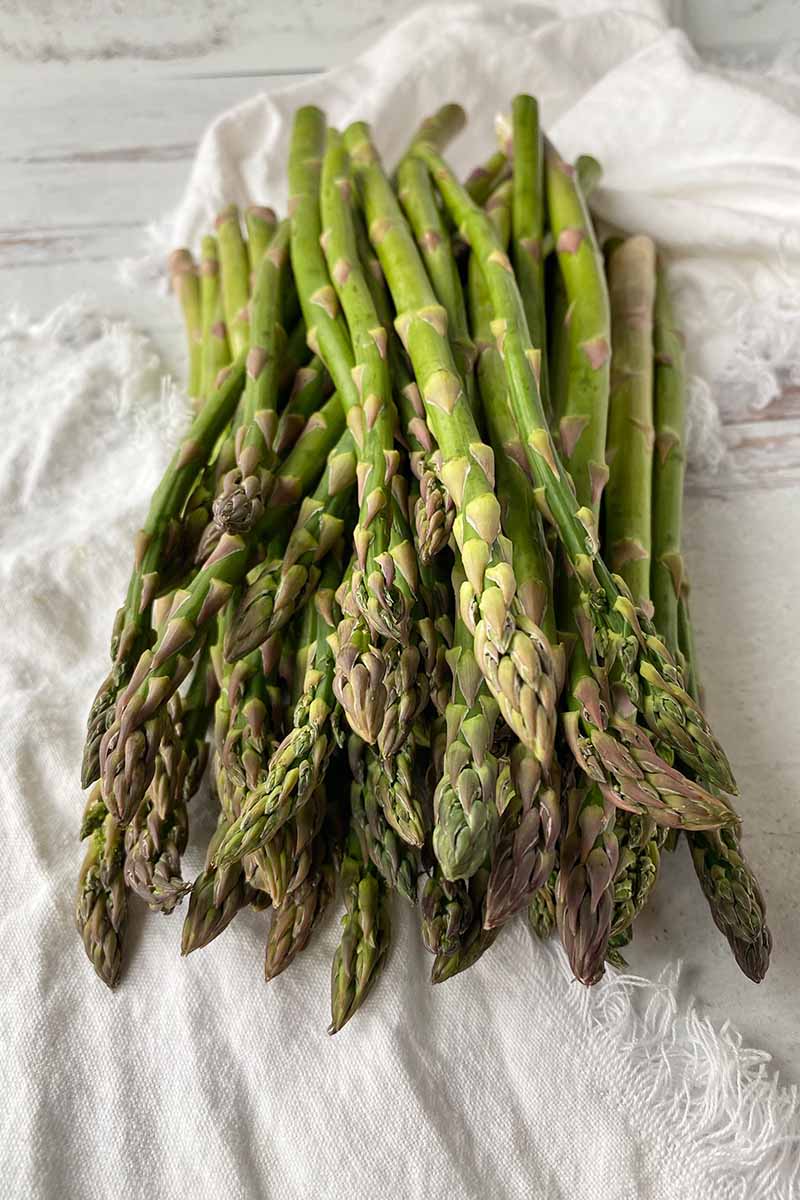
The season typically begins in early spring and lasts until the middle of June in temperate zones of the Northern Hemisphere.
And there are many varieties available to grow and purchase – far more than just the pretty green spears you usually see at the grocery store!
If you’re interested in growing your own, and really wish to know all things asparagus, you can learn how to grow it like a pro on our sister site, Gardener’s Path!
Asparagus plants have two separate sexes, male or female, and growers may plant heirloom or hybrid varieties.
All-male hybrids generally produce a larger quantity of thicker spears, because energy is not diverted to fruit and seed production later in the season as it is in the female plants. These include popular green cultivars like ‘Jersey Knight,’ ‘Jersey King,’ and ‘Jersey Supreme.’
Stalks with a white color can be grown from any variety by restricting sunlight exposure and reducing chlorophyll production. This type typically has a more delicate taste and aroma compared to green stalks, with some slight bitterness towards the stem end.
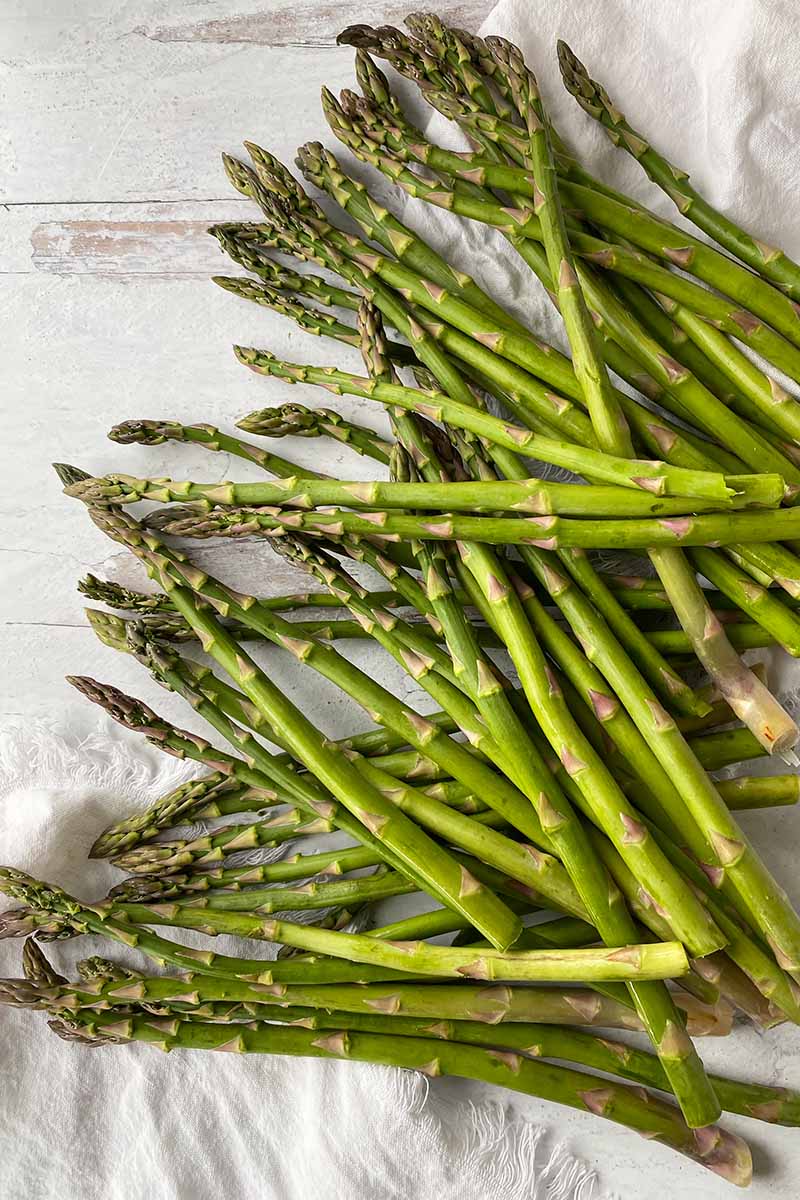
Purple varieties, such as ‘Purple Passion’ or ‘Sweet Purple,’ are popular not just for their gorgeous hue, but for their sweeter taste and more tender texture.
And that sulfurous odor you may notice during a bathroom trip soon after consuming even just a few stalks?
It is more than likely linked to the body’s digestive breakdown of asparagusic acid and other sulfuric compounds present in the spears. Read more about it in our guide to asparagus pee.
While some can smell this strong aroma and others cannot, this small excretory embarrassment shouldn’t prevent you from enjoying delicious and healthy recipes featuring your favorite springtime spears!
Selecting the Best Produce
Here are some tips for you to check how fresh the stalks are when you are shopping at the store or farmers market:
Look
The visual appearance of the fresh vegetables will be an immediate indicator of the quality.
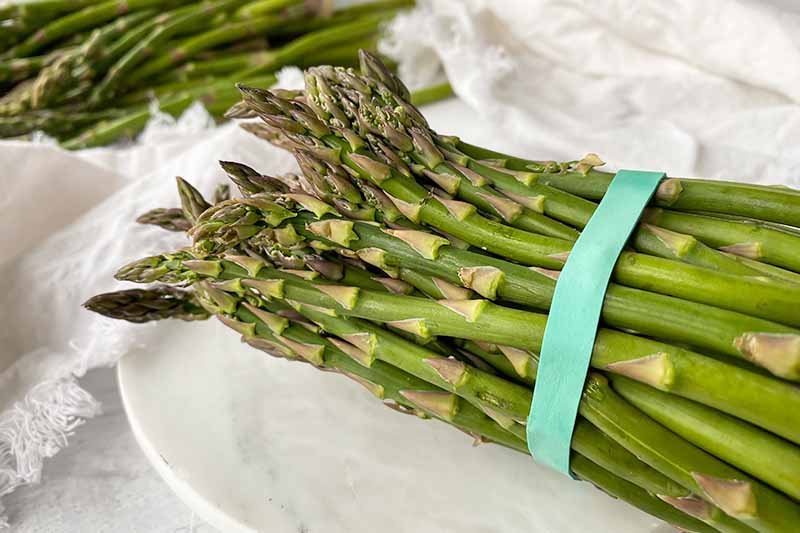
Do the spears look very dry? Older, tougher stalks will need to be trimmed, and perhaps peeled as well, to remove the fibrous outer layers.
Also, be on the lookout for hollow stalks, another indication that the ends of the stalks are dry and will need to be thoroughly trimmed when prepping at home.
Do the spears look too wet? If there are any soft brown discolorations, or the stalks and tips look excessively soggy and mushy to the point of disintegration, you are better off going to another grocery store, or trying a local farmers market.
These are well past their prime, and you should not buy them.
Feel
Don’t be afraid to touch the produce – fresh spears should be strong and sturdy, with some slight flexibility when you gently bend them.
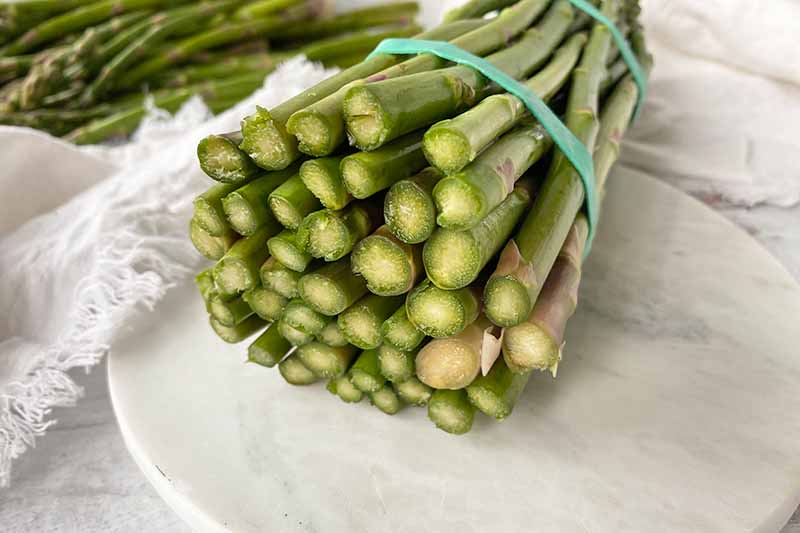
They should not feel soft and limp, and pressure marks should not result when you touch or try to bend a stalk.
Again, mushiness is an immediate sign that the spears are no longer fresh. Avoid, avoid, avoid!
You can also squeeze the cut end of one spear. Ideally, some liquid should come out if you squeeze gently. If the cut end is excessively dry, you will definitely need to trim the ends.
Smell
Go on, take a whiff! The vegetable should subtly exude a light, sweet, and “green” aroma, but it should not smell rank or oxidized.
These are all general guidelines to check for freshness – in the end, simply use your common culinary sense!
In some recipes, the quality of your fresh produce does not have to be perfect – if you are planning to cook and puree them for soups or sauces, the spears do not have to be absolutely pristine. So don’t judge too harshly.
But especially when fresh produce is locally grown and at its peak, like asparagus in the springtime, it’s really not asking too much to be on the lookout for the best quality!
Prepping Basics
After they are harvested, the fresh spears will quickly lose moisture and become increasingly fibrous, starting from the base.
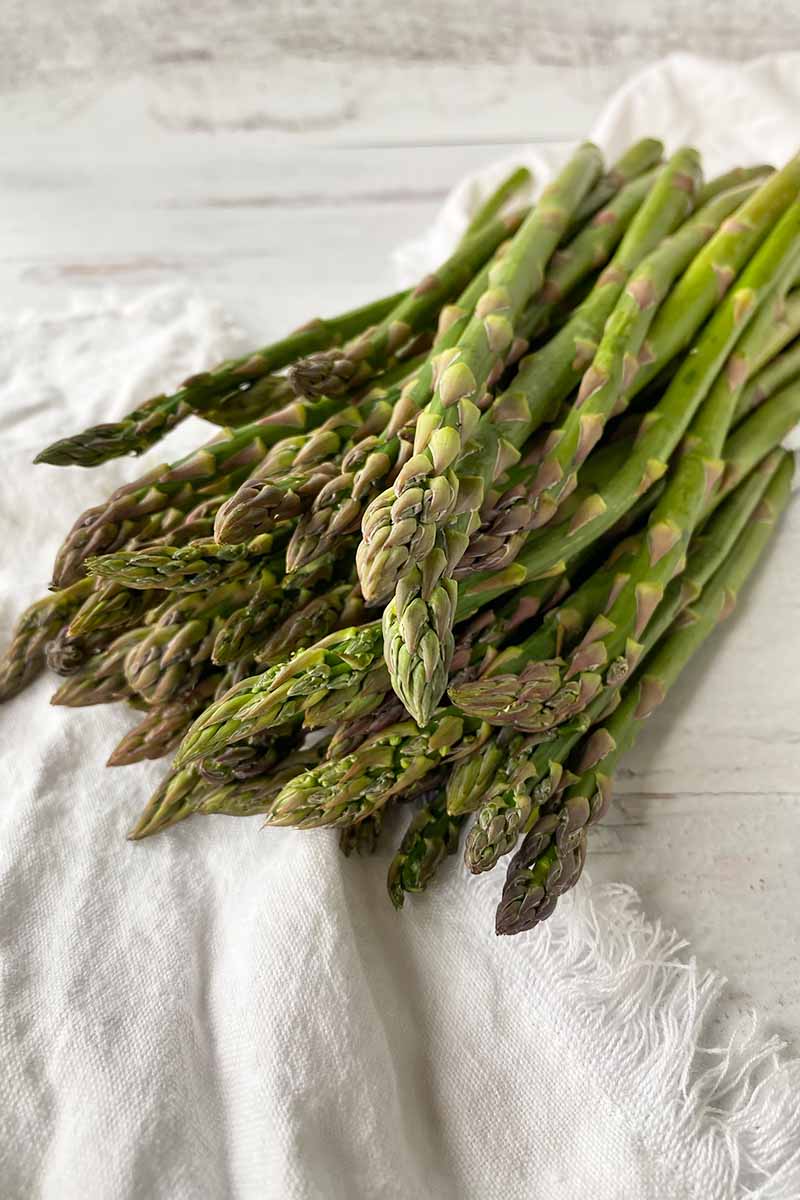
These changes occur the fastest during the first 24 hours after harvesting – which is why growing your own, or buying them directly at a local farm stand, is preferred to stalks that have been shipped long distances, or sat on a shelf for days or weeks.
More mature stalks, those left to grow for a longer period and harvested late, will also be more fibrous compared to a younger harvest.
And the white variety will be more fibrous than green or purple varieties, and will therefore toughen more quickly.
That being said, you will need to do some necessary prep work before cooking your fresh haul, in order to yield the most pleasant eating experience.
Step 1 – Wash and Dry
When you’re ready to cook, remove and dispose of any bands or ties holding the bunch of spears together.
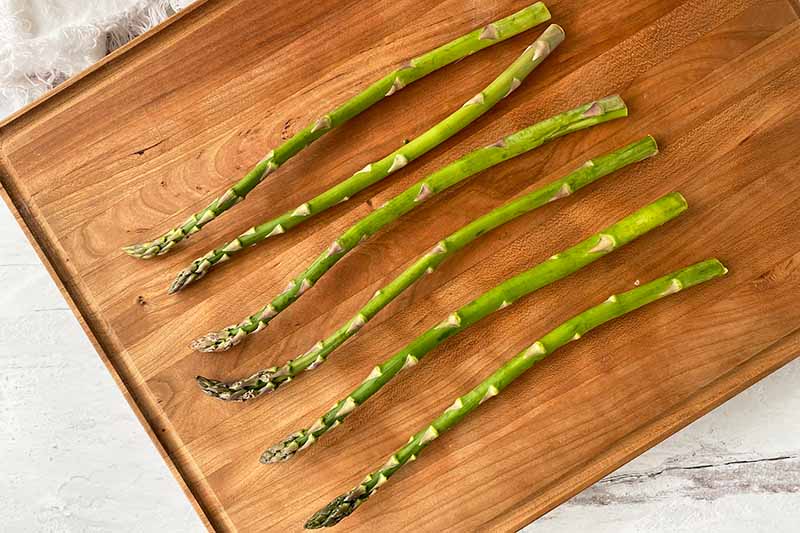
Place the spears in a large colander and wash under cold running water.
Thoroughly dry the spears with a kitchen towel to remove as much water from the surface as possible, being careful to not crush the delicate tips.
Step 2 – Trim the Bottom Ends
Trim the bottom ends of each stalk. You need to remove this portion for two main reasons:
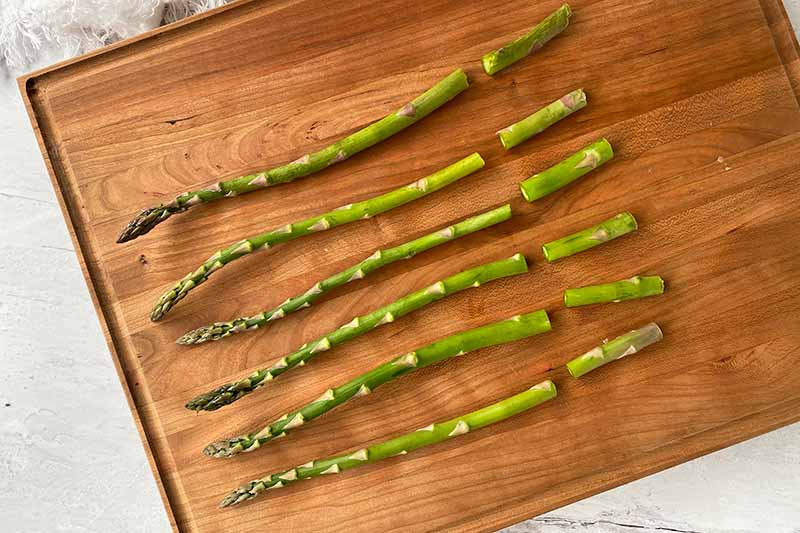
First, the bottom end is where the fresh stalks are cut and harvested – this exposed end may be dried out, and not the most palatable or sanitary to eat.
Second, as explained previously, the most fibrous and chewiest part of a stalk is the lower third – slicing the base will remove the woodiest section.
Generally, slicing the lower third of the spears away is effective enough. However, a common method to locate a more exact slicing point is to bend one stalk until it breaks naturally.
Use this natural breakage point as a guideline for where to slice the remaining stalks during your prep stage.
Save any discarded pieces if you make your own compost. Do your part to reduce your food waste!
Step 3 – Peel the Outer Layers (Optional)
Do you often find yourself in an unpleasant situation involving endlessly chewing on the woody fibers of poorly prepared spear during dinner?
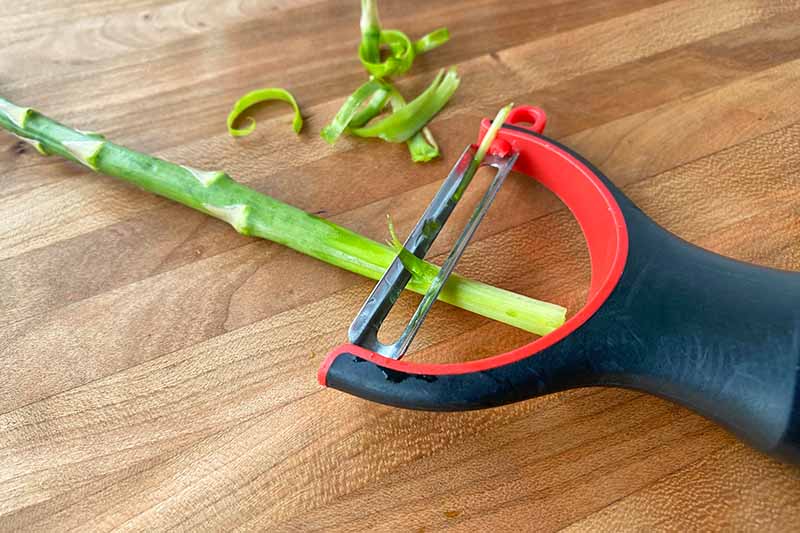
An additional, but completely optional, step to ensuring the lower third of the vegetable is tender enough is to peel some of the outer layers.
If you are aware that your produce is more mature – typically more girthy than thin – or the spears seem to be on the drier side, you may want to consider peeling in order to remove the outer layers that may be too fibrous to break down easily when you’re eating.
After the ends are trimmed in the previous step, use a vegetable peeler to peel away some of the outer layers from the lower third of each spear.
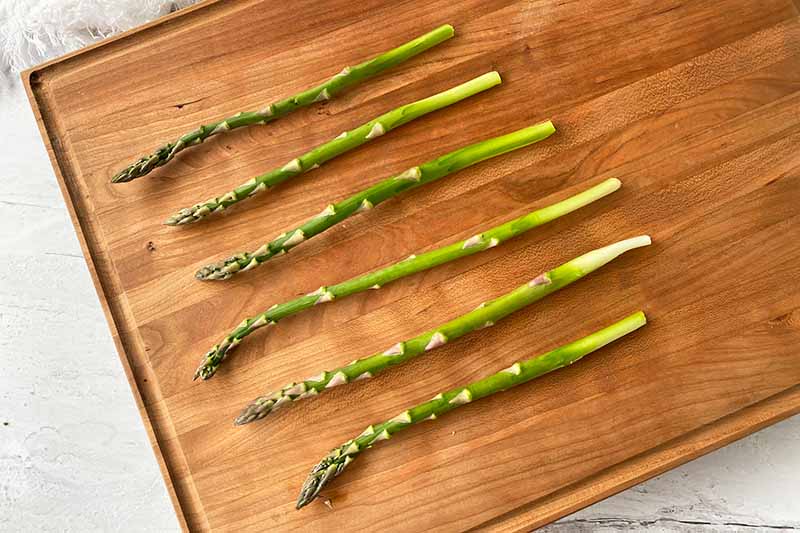
You just have to be careful that you don’t peel off too much of the tender inner layers of the vegetable.
But don’t throw away the peels either! You can use them in your compost, or you can also use them if you are making a soup that will be pureed or strained.
Step 4 – Slice in Pieces (Optional)
Once you have trimmed and peeled the spears, you can either move forward with your recipe if they need to be left whole, or you can slice them in the appropriately-sized pieces as your recipe requires.

Slicing on a bias makes for a nice presentation.
Storing the Spears
You can keep fresh spears for a short period of time in the refrigerator. They can also be kept in the freezer for long-term storage, though this type of storage option will result in a loss of quality.
Refrigerator Storage
For fresh eating, you can store your farmers market or grocery store haul in the refrigerator for about a week.
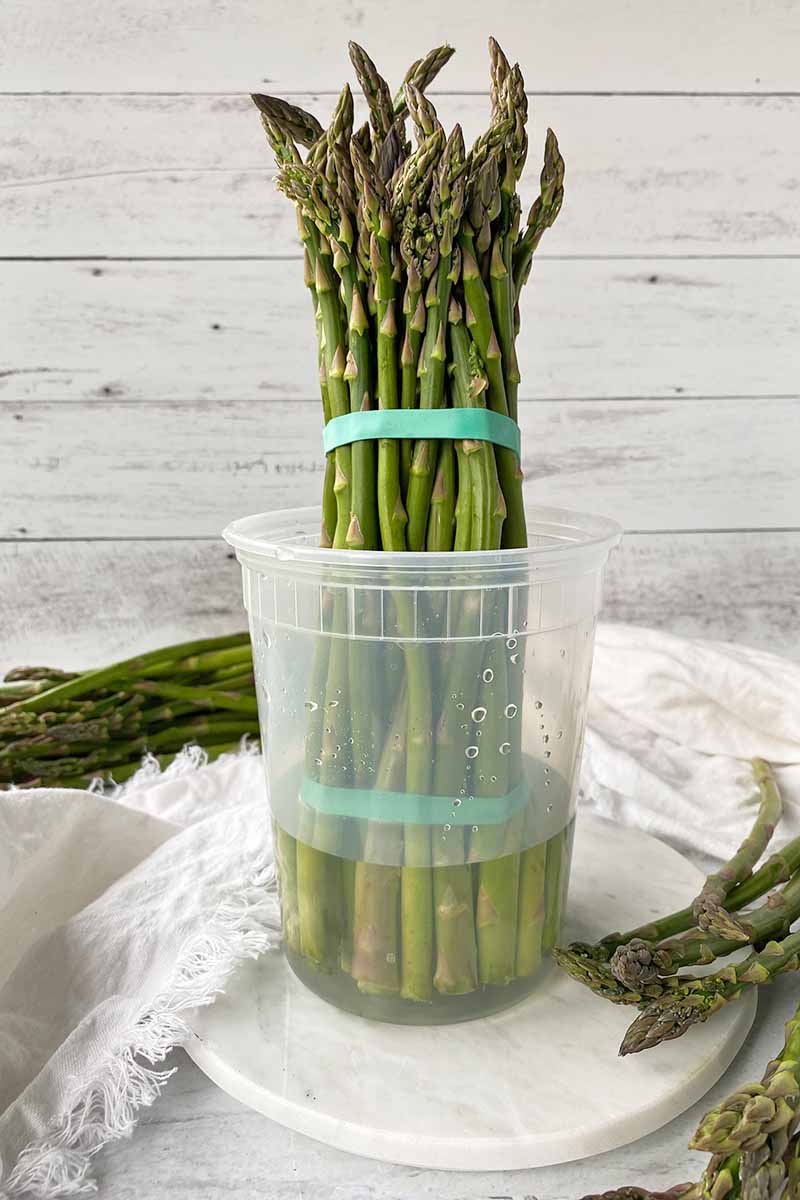
So they don’t lose any more moisture, but without wetting them to the point of excess, you can apply two different refrigerator storage methods:
You can lightly wet a kitchen towel and wrap it completely around the bundle of asparagus, making sure the cut ends at the base are completely covered. Store the bunch in your vegetable crisper drawer in the fridge.
Or, you can stand all the stalks straight up in a tall container filled with a few inches of water in the fridge, enough so the ends are fully submerged, and tent the tips with a plastic bag.
You will need to replace the water every couple of days when it becomes cloudy.
Freezer Storage
You can also store them in your freezer for up to 6 months.
For the best texture after it’s defrosted, I recommend freezing blanched and shocked spears rather than storing them fresh.
If you need some help with blanching, we go over this process in detail in our recipe for fruity asparagus salad.
After blanching and chilling to stop the cooking process, freeze the spears – whole or cut – in a single layer spread out so they aren’t touching each other on a baking sheet lined with parchment paper. When completely frozen in a few hours, you can transfer the pieces to an airtight container or bag to prevent freezer burn.
Freezing will still change the texture of the spears, and they will generally be more watery and less crisp. Freezer storage is an excellent option if you have a surplus after taking advantage of a sale or growing your own, but the culinary applications for frozen spears are more limited.
Don’t serve previously frozen asparagus raw, and avoid recipes that call for roasting. Instead, choose recipes like risottos, soups, or pasta dishes – anything where the vegetable plays more of a minor character, rather than a leading role. These will be perfect to use with defrosted stalks.
Cooking Options
There are so many ways to incorporate these beautifully vibrant veggies in your cooking, from roasting to risotto.
But let’s get back to basics, and first review the easiest methods to cook the spears. Once you understand and become confident with the basics, you’ll be able to find creative and tasty ways to customize these simple techniques in your own home cooking.
Basic Cooking Methods
For the most simple and straightforward preparations, review our tutorial on cooking asparagus with multiple methods. We focus on three main cooking techniques – roasting, steaming, and blanching – and we also provide our favorite ways to add more flavor.
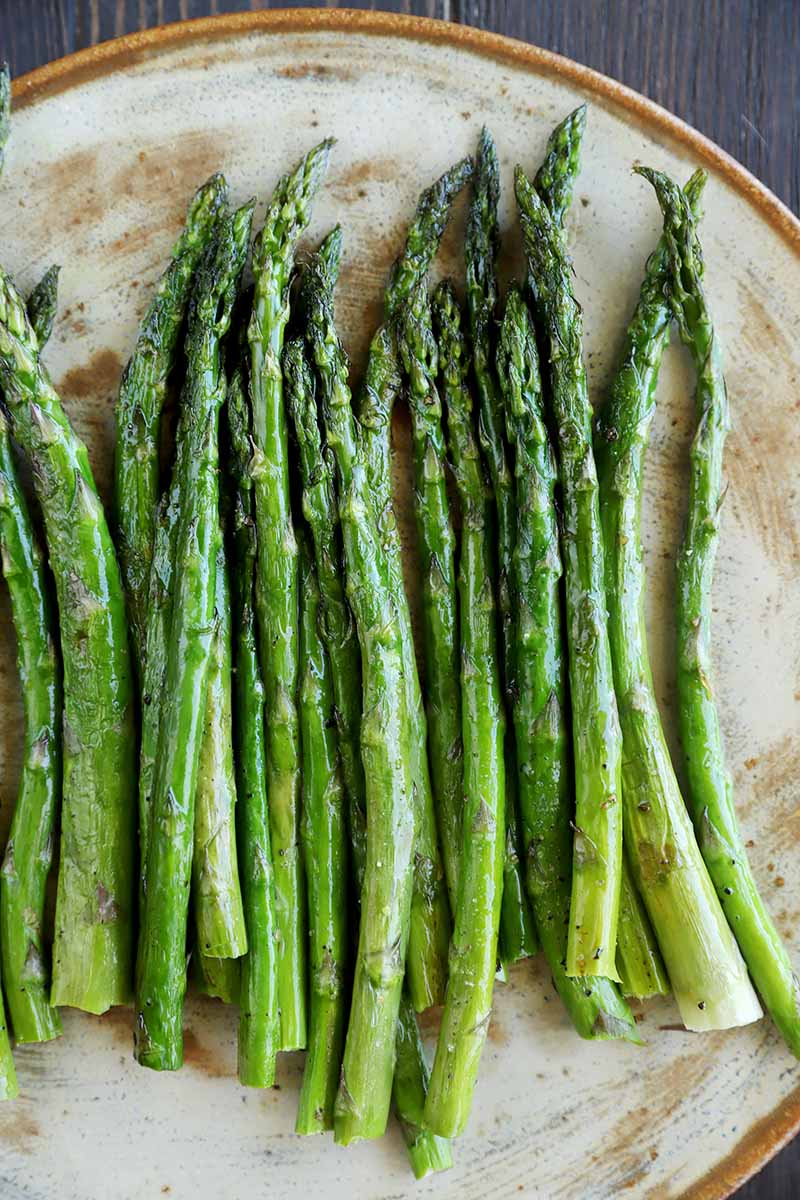
To get the most use out of your kitchen appliances, you can also quickly and simply prepare it in the electric pressure cooker.
If asparagus is – or becomes – one of your favorite seasonal foods, consider purchasing a specially designed pot that gently cooks the spears while they’re standing upright, which can help tougher ends cook at the same rate as the tender tips.
Only the lower part of the vegetable is submerged in the water while the rest is gently steamed.
Demeyere Resto3 Asparagus/Pasta Cooker Set, available from Sur La Table
This Demeyere Resto3 Asparagus/Pasta Cooker Set, available from Sur La Table, is made of a solid 18/10 stainless steel. It includes a cooking pot, mesh insert, and a lid.
Grains and Pastas
Asparagus spears provide a vibrant and fresh addition to hearty grains and pasta dishes. Make any of the following to serve as a hearty and carb-y main course:
- Pesto Chicken Pasta with Sun-Dried Tomatoes
- Lemon Asparagus Risotto
- Rigatoni with Asparagus and Balsamic Reduction
- Vegan Vegetable Risotto with Oven-Dried Tomatoes
You’ll know these recipes are winners when everyone at the table starts fighting for second helpings!
Sides
Are you looking for elegant side dishes that can accompany a main course? You’ll like these beautifully prepared recipes:
- Garlic Asparagus Amandine
- Asparagus, Cheese, and Sausage Frittata
- Roasted Asparagus with Walnut Crema and Pecorino
- Baked White Asparagus (Served with Tilapia)
All of these preparations keep the asparagus spears whole, providing a breathtaking presentation on the plate.
Salads
For a fresh take on salads, incorporate fresh stalks! Try the following recipes when you want a lighter meal you can munch:
- Warm Vegetable Salad with Dates, Roasted Walnuts, and Pecorino
- Asparagus and Snow Pea Salad with Black-Eyed Peas
- Asparagus and Broccoli Salad
- Purple Cabbage and Shaved Asparagus Slaw
Whether it’s served warm or cold, have fun with the playful mix of ingredients in each salad recipe.
Spring Has Sprung – And So Has Asparagus!
Now is the time to take advantage of the short harvest window, and use the freshest asparagus whenever and wherever possible!
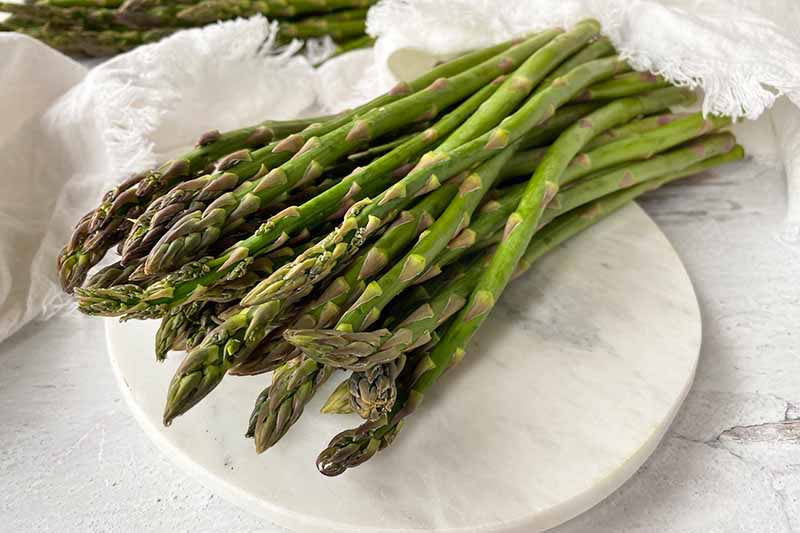
Celebrate the return of spring by making soups, salads, pastas, risottos, and more featuring these tender spears.
Do you have a favorite variety you like to buy, or grow yourself? What’s your favorite recipe? Leave a comment below!
If you want to learn how to perfectly prep and cook other types of fresh produce, continue reading more of our comprehensive step-by-step tutorials. You’ll be a produce whiz soon enough! Let’s start with these fun ones next:
- How to Prep Onions
- How to Get the Most out of Fresh Berries
- How to Cook Broccoli, Three Different Ways
Photos by Nikki Cervone and Meghan Yager, © Ask the Experts, LLC. ALL RIGHTS RESERVED. See our TOS for more details. Originally published by Nina-Kristin Isensee on April 25, 2015. Last updated on April 12, 2023.
About Nikki Cervone
Nikki Cervone is an ACS Certified Cheese Professional and cheesemonger living in Pittsburgh. Nikki holds an AAS in baking/pastry from Westmoreland County Community College, a BA in Communications from Duquesne University, and an MLA in Gastronomy from Boston University. When she's not nibbling on her favorite cheeses or testing a batch of cupcakes, Nikki enjoys a healthy dose of yoga, wine, hiking, singing in the shower, and chocolate. Lots of chocolate.

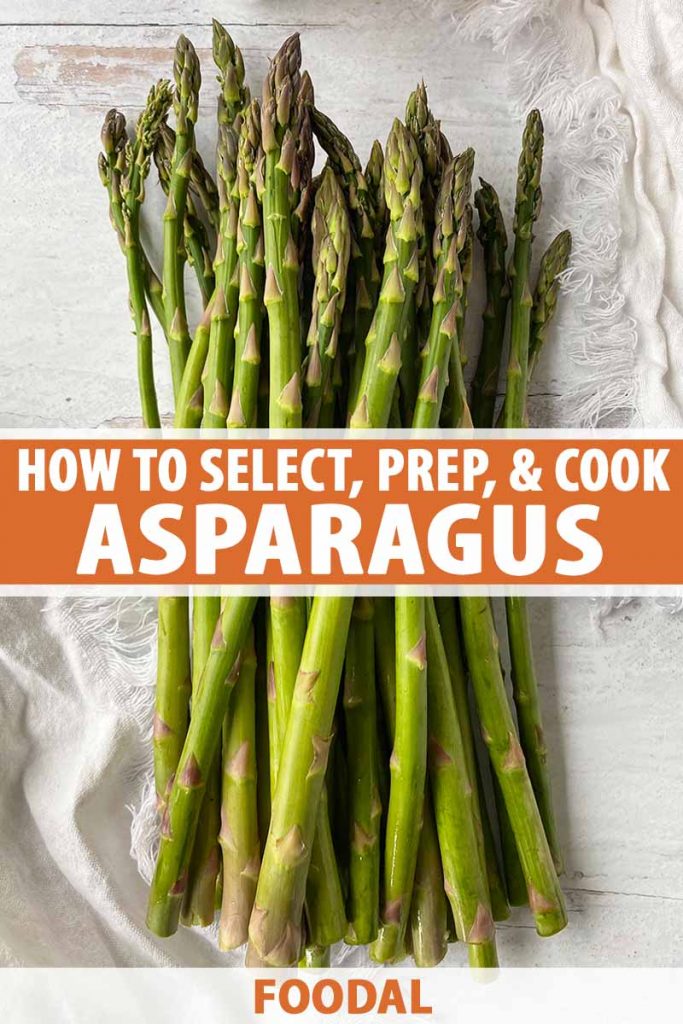
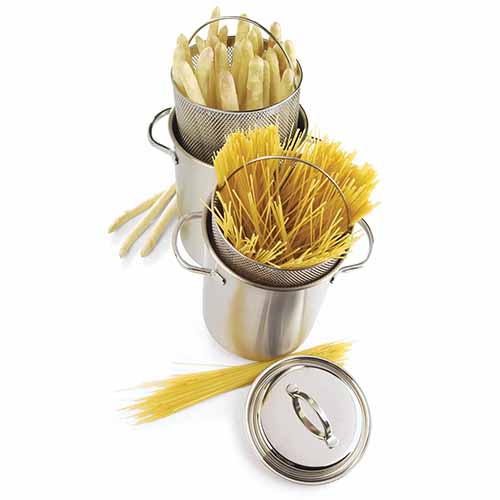



I’ve been eating asparagus my whole life and I never would have thought to try it with fruits. I’ll definitely have to try that. The soup recipe also looks super easy to replicate, and it sounds like the end result is super tasty. Useful tips for finding the best stalks as well!
Although I do enjoy the recipes you’ve mentioned in the article, there are 2 favorite ones that I absolutely cannot resist. I’m talking about the chicken asparagus roll-ups, I love the taste of mayonnaise and mustard in those! Also, the risotto you make with the asparagus leaves me wanting for more!
Asparagus is one of my favorite vegetables and besides having it as a breakfast dish, I also use it chopped up in stir fries or with pasta dishes. When roasted, it is easy to make and is versatile to eat by itself of chopped up and tossed into a salad. Using it in soups is great and I mix it with spinach for an extra dose of green vegetables.
That’s a nice combination! Asparagus and spinach work well together – and look great too! It’s quite versatile, you’re right. I am always looking for recipes that use ingredients/vegetables in ways I haven’t tried them before. Experimenting by oneself and discovering new ideas is always a joy too.
I’ve always been a huge fan of asparagus. Pickled asparagus is a new favourite that I got into last fall. However, that’s not much of a spring vegetable thing. This summer I’m tossing asparagus on a grill to optimize the flavour. Don’t knock me if I wrap it in a bit of prosciutto too.
Oh, I love the sound (and look!) of your fruity asparagus salad! That’s completely new to me, and a recipe I would really love to try before the season is over.
Like you, I prefer to eat asparagus when in season – it just doesn’t taste the same otherwise, so I go completely mad with it for a short while. My favourite way to eat it is to very lightly steam it, and dip it into a soft boiled egg fresh from one of my hens that day.
I will definitely give the fruity salad a go this week – thank you!
I’ve never eaten asparagus, much less bought it or cooked it. I’m thinking that might have to change. That salad looks Really great!
Thank you for the tips and recipes! This is going to have to get bookmarked.
I haven’t eaten much asparagus, so this seemed like a good article to read. I’m surprised to learn that I should peel at least part of them, and I wasn’t aware that the white variety even existed. I like the idea of using the vacuum sealer to freeze the asparagus, because that could simplify meal preparation, and your soup recipe looks very tasty.
I love the Lynne’s Notes, and I had no idea that farmer’s markets could (or would) sell produce they hadn’t grown themselves, those sneaks! That’s something I will check into, because I’ve been to a huge one in Houston, and now I’m wondering whether it was all from this area, or imported from other locations.
Growing up in an Asian household, we didn’t really eat asparagus (and even during the summer when we grill things we grilled other veggies like bell peppers and zucchini or just had salads). I didn’t really start eating asparagus until maybe beginning of college and it was love at first taste.
Asparagus is one of those vegetables that you can do anything with; cold salad, warm pasta toss, soups, etc (okay not everything, maybe not dessert). I have this great pasta recipe that calls for asparagus and sun-dried tomato and mozzarella…makes my mouth water just thinking about it!
However, my go-to recipe is still the oldie: olive oil, salt, pepper, and pop it in the oven.
I love asparagus but have been stuck eating it baked or boiled with butter and water. I think I want to try the soup it reminds me of a kid and eating pea soup. When the next holiday comes I will try the fruit salad recipe and I hope the adults enjoy it. Sometimes when you offer a new salad people will look at you funny – however I’m still up for the challenge. Thank you!
I know what you mean. In my family, asparagus was also always served boiled with butter sauce and potatoes aside.
Eventually, I started collecting different recipes and I enjoyed preparing it in lots of ways. And indeed, I could convince my family of some new ideas. So I hope you’ll be lucky with the salad too. When I first prepared it, I was really surprised of how well the berries and the asparagus go together.
Personally, I don’t enjoy asparagus as much as my family does, but I’m definitely attracted to the pictures you have provided for each recipe. The tips you gave for picking the spears were extremely helpful as well; I like how you categorized the aspects of the vegetable. I’ll attempt at making the fruity salad for my family; that shouldn’t be too terribly difficult. 🙂
Thank you! Especially when it comes to asparagus, there are different aspects that are important concerning the freshness, so I tried to find an appropriate guide. I am glad it is helpful 🙂 I hope your family will like the salad, but I’m sure the fresh-and-fruity mix will be a winner.
This guide was so helpful! Up until now, I hadn’t found a good and concise guide to for harvesting these beautify and tasty spears. I appreciate the different cooking methods, I’ll be trying the half boiled half steamed method. The salad looks amazing too!
I haven’t actually tried asparagus soup. I eat it from time to time but I bet this is going to be really good. I didn’t know that this is what makes it a diuretic. It is so good for you to eat. Seems to digest really well too.
I am always on the lookout for interesting veggies so I will keep my eyes peeled for white asparagus!
You’re right though I have not noticed them here in North America at all.
Wow, this post explains a lot of my asparagus troubles in the past. Not once, ever, have I tried your methods to check and make sure I’m getting a fresh product. I’ve also never peeled my asparagus. Very helpful, thank you! I want to branch out more with my vegetable cooking, because I largely stick to what I know… stir fry! Don’t get me wrong, I love my stir fry, and have honed my stir fry making to a yummy Alex- brand. However, stir fry gets old and I want to incorporate vegetables more into my diet. So, I look forward to trying these methods!
Thank you, I’m pleased to hear that this will help you when buying asparagus the next time.
I totally understand what you mean. One often sticks to the ingredients and ways of preparation one is good at and one knows how to work with, I often catch myself doing the same 😉 But once you tried it, I’m sure you are going to include it to your permanent collection for some tasteful variety!
I really do like asparagus, and always use the tip in this article about allowing the spears to snap naturally so that you only get the fresh part of the vegetable, there’s nothing worse than trying to chew through a mouthful of what feels and tastes like wood!
You’re so right, this is an important step for asparagus. Sometimes, when eating out and ordering asparagus when it’s fresh here in Germany, I have experienced that it had this woody nuance, and it’s just not a pleasure to eat it.
I’m a big fan of asparagus but I have never tried the white variety, I don’t think I have ever seen it, I’ll look for it during my next grocery store trip. The soup recipe sounds amazing and very easy to make, thank you for sharing it, I’ll try it out as soon as possible. I also love it mixed with risotto, I could eat it every day! Another one of my favourite recipes it include it in is frittata, it tastes very good and my dinner guests love it.
I had never thought about combining fresh spears with fruit, I’ll definitely try out your fruity salad recipe, thank you.
That is really an interesting fact, because here in Germany the white variety is soo popular. It seems like this is really a country-specific thing. But maybe you’re lucky and you’ll find some sticks somewhere, I’ll keep my fingers crossed.
As a big fan of risotto in general, I totally agree with you. This veggie is a perfect addition. Including it in frittatas seems like a wonderful idea too, though! Hope you like the salad, I ‘m always surprised again how well the ingredients fit together.
That salad is a must-try! What a gorgeous plate.
This is one of my favorite vegetables. I’ve actually never had the white variety, though, and will have to check it out.
Happy you like the combination!
Although the white one is much more common where I live, I just love the green stalks. Maybe, it’s because of the nice dash of color on the plate 🙂
However, if you ever get the chance to try the other sort, go ahead, and enjoy the diversity!
Oh my gosh! I had no idea I had to peel asparagus! This is definitely my aha moment in regards to asparagus. I have made SEVERAL failed attempts at making asparagus and it always results in rubbery, tasteless food. We are trying desperately to incorporate more veggies in our diet and everyone seems to rave about asparagus but I could never get it right lol. Thank you for the info!
I’m glad that this article could help you for the next time you’ll be serving this great veggie. I’m sure it will work out better then. Hope you have fun including the colorful stalks in various dishes!
I’ve cooked asparagus for forever and never have thought to peel it. Perhaps that is because I never buy the fatter stalks. I also don’t buy the very thin stalks. I guess I choose the happy medium so the entire stalk gets cooked. I’ve taken to “cutting” the stalks although I once heard you should snap them because “asparagus will tell you where it wants to be cooked.” But I found I was wasting too much that way.
Currently, my favorite way to cook it is to line spears up in a cast iron spear and roll them back and forth until they get brown/black. When the skillet is piping hot, I add butter in the middle and coat the spears. Then I add just enough vegetable stock to cook them to fork tender. It’s amazing flavor. Thanks for the other ideas! I’m looking forward to summer already.
Thanks for you comment – and your delicious serving idea. I could have a portion right away and it has come just in time for the veggie’s season start here in Germany. While I thought about preparing some stalks the way I’m used to, I think I’m going with your recipe tomorrow 🙂 Thanks for the idea!
As a student of biochemistry, I found the bit about asparagine interesting! Now I know where the name came from! And I didn’t know the difference between the white and green varieties. This is a vegetable I absolutely adore in many forms, especially with salmon and a drizzle of lemon and pepper. And like other people here, I was unaware you could peel them – I always ended up with chewy, hard to eat asparagus. Not anymore!
That sounds delicious! I think salmon works amazing with this veggie – sometimes it doesn’t have to be a fancy combination. Simple things like this can make a fantastic meal, too!
I’m happy that I could provide you with some helpful information concerning the peeling. And I hope, in the future you will enjoy some crunchy, tasty stalks!
I love lightly steamed asparagus with butter and freshly grated pepper – and to eat them with my fingers. We have a lot of the wild variety growing locally along the edges of the vineyards and the forest – I pick a bunch each day and, as they’re so slender (and squeaky!) barely pass them over hot water – just enough so that the butter will melt.
Oh that sounds amazing. I would love to have the opportunity of picking some wild grown stalks nearby. I think they must taste wonderful. And again, not much else is needed to turn them into a fantastic meal. The combination of butter and pepper gets the best out of it, I suppose. A wonderful fresh and healthy summer dish 🙂
Thanks for covering one of my favorite veggies. Asparagus is extremely underappreciated, which I think is due to the stories how it makes your pee smell bad. While this is true, it is a delicious vegetable. After several different preparation methods, I still find that the best way to cook them is a simple coat in oil, salt, and pepper and throw them on the grill. I feel that a nice char really brings out the natural flavor. I definitely want to try the Fruits Asparagus Salad recipe though. It seems interesting!
I think you’re right – that might really be one of the reasons.
Plus, I agree with you on grilling the stalks. As several other readers have also mentioned this, that brings out a wonderful flavor. With some seasoning and some drippings of oil, it makes a perfect veggie dish 🙂
However, enjoy the fruity salad – it’s a nice combination as well.
Thanks for the soup recipe! I will certainly try that very soon. I may be biased towards this, but anyone who doesn’t like this veggie should really consider to BBQ it for a bit! It’s mouthwatering and it really is an explosion of flavours together with that typical charred BBQ taste. Now I’m hungry!
I always thought that I wouldn’t like the taste because I’m not the type of person to try out new veggies and I’m a texture person as well. If something is too slimy, squishy, rough, etc. it throws me off and I won’t eat it. All of the ladies in my office love asparagus so they finally convinced me to try it and I must say that I was pleasantly surprised!! It was actually pretty good!!
The most recent “concoction” I tried was my favorite. She took the asparagus, whole, tossed it in olive oil and sprinkled parmesan cheese on top of it. She threw it in the oven at 350 for 15 minutes and it came out delicious!
I want to go to the store now and buy some so I can try it at home but I never knew what to look for. I think the easiest thing for me would be the squeaky trick, definitely something to try. I can’t wait to start cooking them now!!
It’s great to hear that you could have been convinced to try it 😉 Even better that you enjoyed it! Roasting the veggies in the oven is a fantastic way to prepare them – especially with some parmesan on top, yummy! Thanks for the tip and the instruction.
I hope you will be lucky finding some squeaky fresh stalks!
Well I have really had a love hate relationship with asparagus throughout my life, with much of the hatred coming in my early years. I used to never ever give this one a shot when I was growing up, and even when I did I remember not caring for it much at all. Soon enough, though, I came around, but I still only like it certain ways. It is very good for you though, so I try to work it in as much as I can.
I agree with you! When I was younger and my parents would like to make it for dinner, I always asked for something else, because I didn’t like it at all! Nowadays, I wish I hadn’t been so stubborn 😉 And I also have my favorite ways of preparation, roasting them in a pan is definitely one of them!
Roasted or sauteed asparagus with garlic and butter are usually the only two ways I have eaten the veggie. It is such a classic accompaniment to steak so that is usually when I consume it. I will have to try the asparagus salad recipe mentioned in the article and find a few more interesting ones, too.
Yummy! You’re definitely right, that is one great side to steak, it’s a perfect and complete meal – great as a low-carb alternative, too. I hope you’ll like the salad and enjoy making it!
Oh, thank you for this information. This is one of my favorite veggies, yet I haven’t had the best luck with cooking it. I don’t always get the texture that I want, and I thought the key too it was not cooking it too long. Good to know that you can do it longer.
I’ve managed to make it passably a few times, but it’s usually hit or miss. Now, I have more to work with. I didn’t even know it needed peeling, so that should definitely help.
I’m happy that these information could help you, I’m sure your next asparagus dish will be successful. The peeling will make it taste much better, enjoy it 🙂
Our family is actually very good with eating fresh veggies (and fruits) daily. With each dinner, we ALWAYS include a veggie. Recently, I have introduced asparagus to my kiddos, and they LOVE it! I typically have a hard time getting them to eat some of the green veggies, so I thought it would be difficult. I cooked them in butter, with a pinch of salt and they asked for seconds!! I think we will start eating asparagus more often. Its not on a daily basis they ask for seconds on veggies, though they will eat the first amount given on their plates.